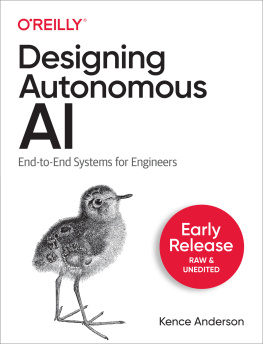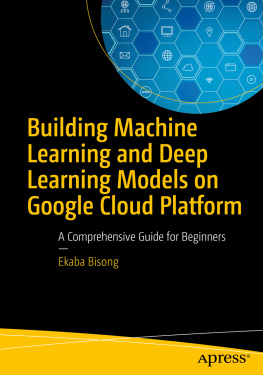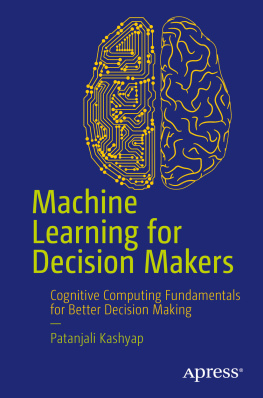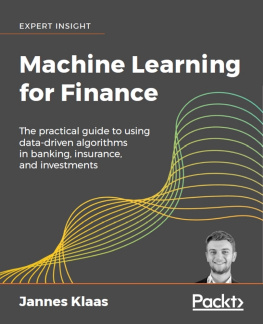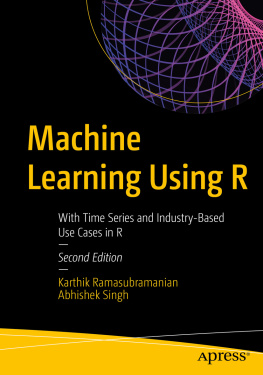Praise for Designing Autonomous AI
An easy and comprehensive introduction to machine teaching, a powerful new paradigm of useful AI for industrial applications that empowers engineers, expert operators, innovation leaders, and business owners to optimize industrial processes by teaching the AI the expertise that took them decades to learn.
Teresa Escrig, Principal Project Manager, Microsoft
By steering clear of the morass of AIs mathematical and programming details, Kence Anderson has produced an engaging book that will appeal to a wide swath of readers with an interest in this transformational technology. His thoughtful examples illustrate the key ideas behind AI in ways that will resonate with readers.
Jonathan Schaeffer, Distinguished Professor of Computer Science, University of Alberta
The insight that learning systems, by design, must be taught spawned the machine teaching paradigm. This book captures hard-won patterns and practices to make applying it to real-world applications successful. If youre building an autonomous system, you couldnt ask for a better guide than Kence Anderson.
Mark Hammond, VP, Autonomous Systems, Microsoft; Cofounder and CEO, Bonsai AI Inc.
Machine teaching is a key skill in the next wave of useful, applied AI. This book is a practical, real-world guide, developed from a wealth of experience empowering subject matters in applying AI to business-valuable projects.
Phil Harvey, Autonomous Systems Architect, Bonsai, Microsoft Research
Kences brilliance shines through in his use of real-world stories and simple analogies to make the complex approachable. This book is the introduction to a technology that will be an inflection point in the world of manufacturing and industry.
Bryan DeBois, Director of Industrial AI, RoviSys
I enthusiastically recommend this book. Kence Anderson, a leading real-world practitioner in emergent autonomous AI, writes about machine teaching with the lucidity and authority of someone who had a hand in its creation (which he did).
Gurdeep Pall, Corporate Vice President, Head of Product Incubations, Microsoft (from the foreword)
Designing Autonomous AI
by Kence Anderson
Copyright 2022 Kence Anderson. All rights reserved.
Printed in the United States of America.
Published by OReilly Media, Inc. , 1005 Gravenstein Highway North, Sebastopol, CA 95472.
OReilly books may be purchased for educational, business, or sales promotional use. Online editions are also available for most titles (http://oreilly.com). For more information, contact our corporate/institutional sales department: 800-998-9938 or corporate@oreilly.com .
- Acquisitions Editor: Nicole Butterfield
- Development Editor: Sarah Grey
- Production Editor: Jonathon Owen
- Copyeditor: Justin Billing
- Proofreader: Piper Editorial Consulting, LLC
- Indexer: Ellen Troutman-Zaig
- Interior Designer: David Futato
- Cover Designer: Karen Montgomery
- Illustrator: Kate Dullea
Revision History for the First Edition
- 2022-06-10: First Release
See http://oreilly.com/catalog/errata.csp?isbn=9781098110758 for release details.
The OReilly logo is a registered trademark of OReilly Media, Inc. Designing Autonomous AI, the cover image, and related trade dress are trademarks of OReilly Media, Inc.
The views expressed in this work are those of the author, and do not represent the publishers views. While the publisher and the author have used good faith efforts to ensure that the information and instructions contained in this work are accurate, the publisher and the author disclaim all responsibility for errors or omissions, including without limitation responsibility for damages resulting from the use of or reliance on this work. Use of the information and instructions contained in this work is at your own risk. If any code samples or other technology this work contains or describes is subject to open source licenses or the intellectual property rights of others, it is your responsibility to ensure that your use thereof complies with such licenses and/or rights.
978-1-098-11075-8
[LSI]
Dedication
This book is dedicated to my father, Lawrence Anderson (19162002), the maestro and master teacher.
Foreword
It gives me great pleasure to enthusiastically recommend Designing Autonomous AI, written by a leading real-world practitioner in emergent autonomous AI: Kence Anderson.
As the Corporate Vice President currently responsible for new product incubations at Microsoft, and as someone who has been closely involved with creation of new product categories like VPNs, real-time communications and now autonomous systems at Microsoft, I have learned that creating new categories is not a straightforward path.
Established product categories and their underlying technologies and business models are well honed for the real world with well understood problems and solutions. These are things we use in our daily lives.
Fundamental research is important to new category creation but lives in the ether of science, generally abstracted from real world considerations. Researchers create novel methods and demonstrate their promise through results in carefully crafted experimentsthe amazing state of the art in AI is a recent example of this.
Importantly, not every method created by researchers is sufficient or workable in the real world. New categories can be created when one or more of these new methods are developed further, grounded in and applied to the real-world environment.
New category creation is a chaotic, primordial process entailing a loop of exploration, learning, and adaptation. This process is very high dimensional and domain dependent; there is no single formula here. However, at the core of new category creation, inevitably there is always a breakthrough clinching idea that solves the most difficult aspects of the real-world problem.
The new category of autonomous AI, which is so significant that it is being called the Fourth Industrial Revolution, is particularly challenging in this regard because the underlying real-world considerations are extremely onerous. Building adequate systems that are safe and performant in the real world is nontrivial. This is a key reason for why we havent seen flying cars outside our window yet.
For autonomous AI, one of those breakthrough clinching ideas is machine teaching. In the same way languages and compilers made the once complex and kludgy task of computing easy, efficient, and accessible to millions of programmers, machine teaching is enabling experts from any discipline (mechanical, electrical, or aeronautical engineering, etc.) to build powerful and usable autonomous systems easily, without requiring a PhD in AI or data science.
Machine teaching, without apologies, borrows from well-established techniques from all schools of thoughts of AI: connectionist, symbolist, and experiential, and from proven methods in pedagogy. Machine teaching provides an easy way to codify human expertise in any domain and to apply the power of learning methods automatically, abstracting away the tyranny of abstruse AI algorithms.
Kence Anderson writes about machine teaching with the lucidity and authority of someone who had a hand in its creation (which he did).
Gurdeep Pall (Seattle, WA, 2022)
Preface
Theres a saying that those who cant do, teach; and those who cant teach, write. Well, thats not how this book came to be. I spent four years traveling around the world to steel mills, mines, factories, testing facilities, design studios, machine shops, chemical plants, oil fields, refineries, warehouses, and logistics centers, learning from subject matter experts about the challenges and opportunities of industrial decision-making, then working with them to design useful Artificial Intelligence (AI) that can help them make better decisions.


